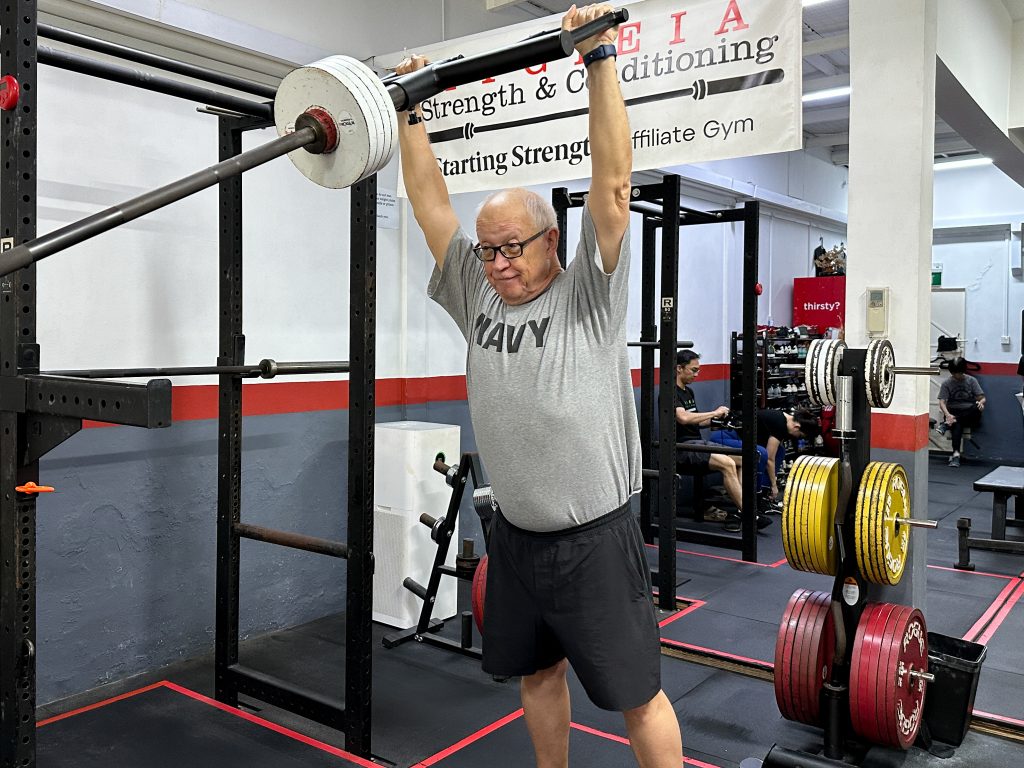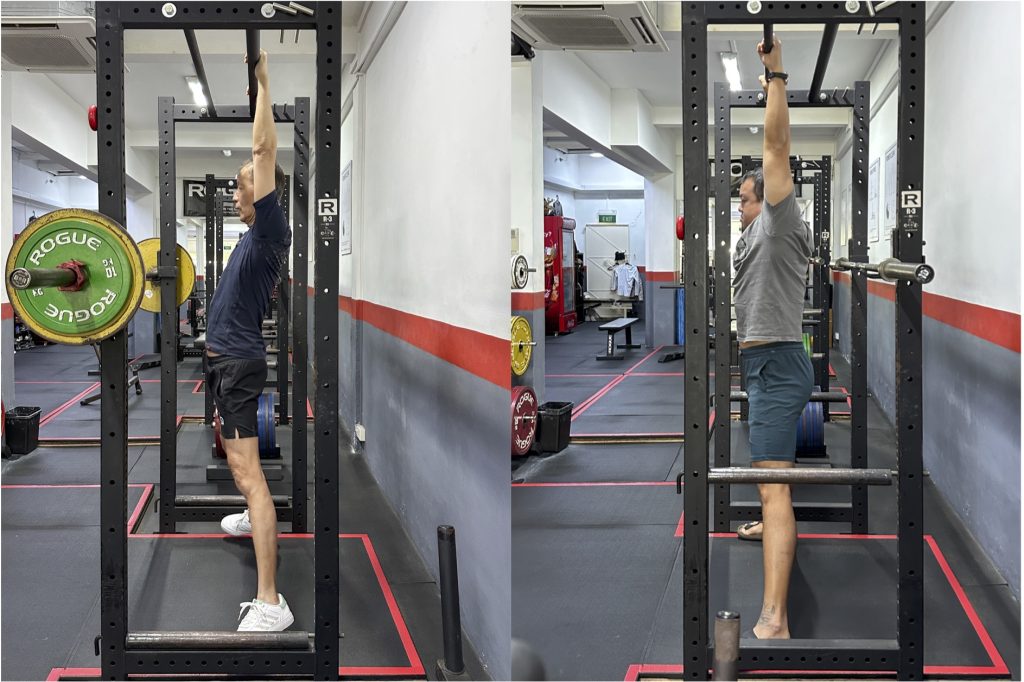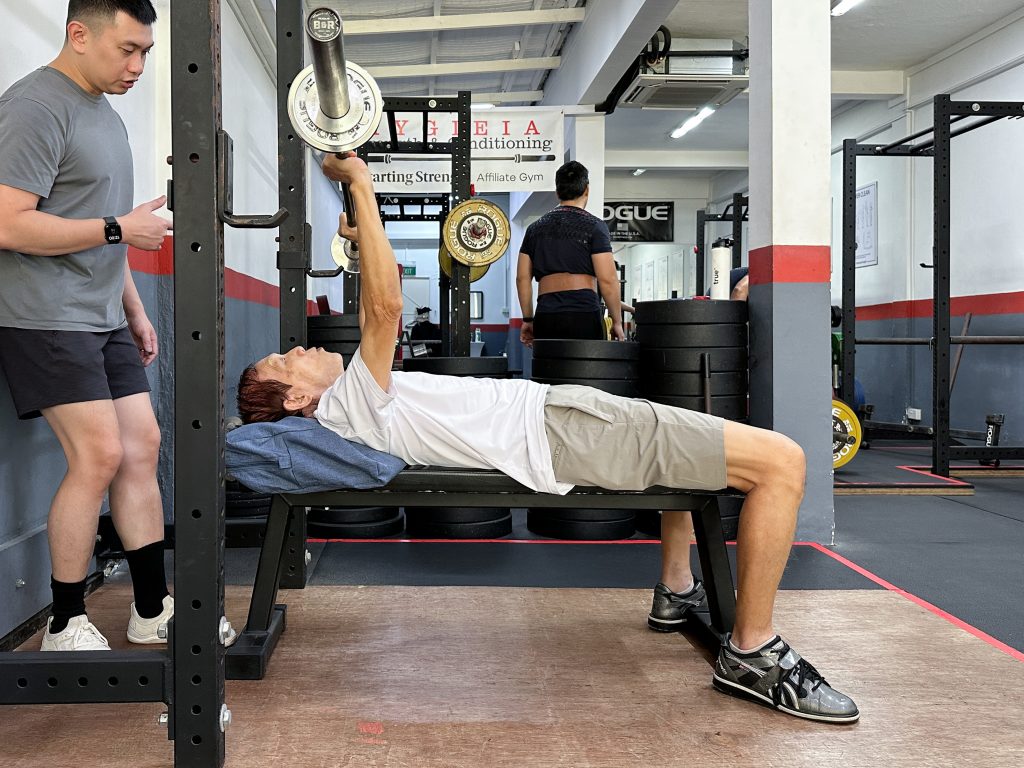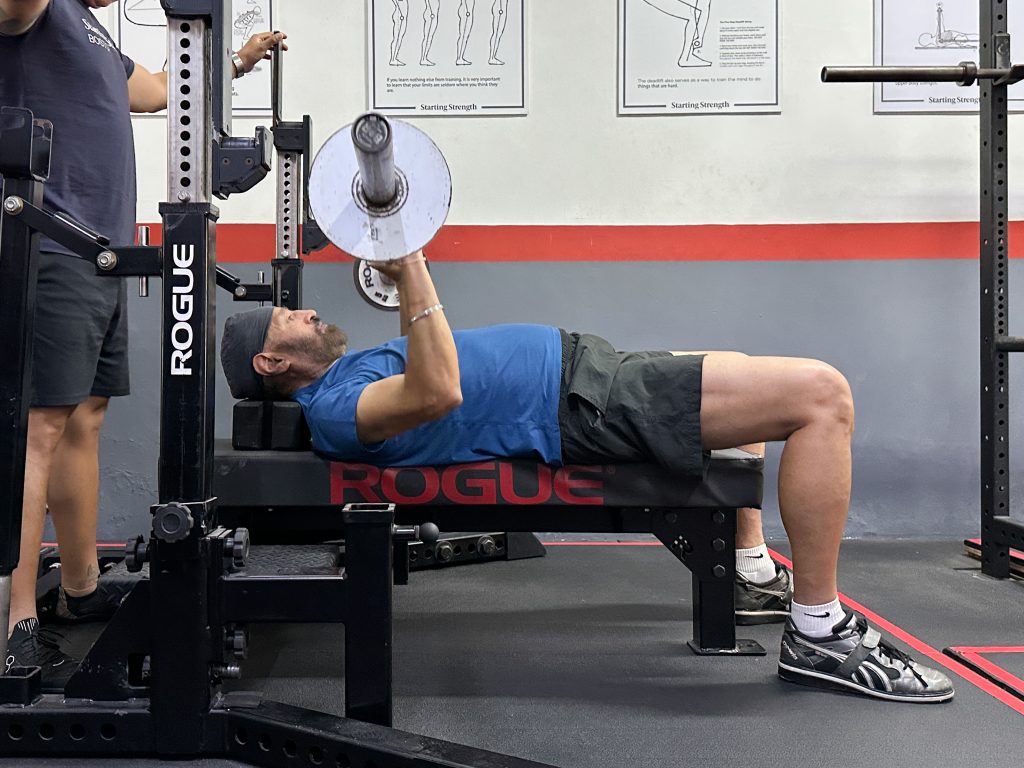
After decades of living, working, and playing hard, it’s not uncommon that most or if not all of our older clients come to us with some form of injury, ache, pain or physical limitation.
One issue that shows up pretty often, especially amongst older guys: shoulder inflexibility. Whether it’s from an old injury, surgery, or just bone structure, their shoulders have lost some amount of range of motion (ROM).
Of the four basic barbell lifts that our older clients do, shoulder inflexibility has the most pronounced effect on the squat and the press, often requiring modifications from the model and work arounds.
How to work around squatting with stiff shoulders has been covered extensively by many coaches, including in our own articles, but not so much for the press.
Today, I’m going to discuss inflexible shoulders and the press: when they can improve, when they can’t, and what we can do about it.
Identifying the root cause: Structural vs. flexibility/strength issues
We categorise the causes of shoulder inflexibility into two general types – soft tissue/strength, or structural causes.
There are several ways we differentiate between soft tissue limitations and structural ones. One telltale sign that a lifter is likely to have structural limitations is thoracic kyphosis—that rounded/hunched upper back posture. Depending on the degree of the kyphosis, it can limit the shoulder’s ability to achieve full flexion. This means the lifter can’t get the barbell into the press lockout position: bar directly over the shoulder joint and midfoot, elbows locked out, shoulders shrugged up.
When a lifter’s lack of shoulder flexibility prevents them from achieving the lockout position on the press, one of two things happens. Either the bar gets locked out in front of the midfoot (which becomes impossible when the weight gets heavy), or the lifter leans back like they’re doing a standing incline press to maintain the bar’s relationship over the middle of the foot.
One way we test if the lifter can achieve the press lockout position is to have them hang from a chin-up bar with a pronated grip (palms facing away from you), about shoulder-width apart, and let their body fully hang. Then we observe whether they can achieve full shoulder flexion. If they can hang with full shoulder flexion but can’t lock the barbell out at the same position when they press, it’s a soft tissue and/or strength issue that we can work through and improve over time. The difference is obvious when you see it.

This dead hang can also serve another function: it lets the client feel and understand what the proper lockout position feels and looks like.
Some of our clients have limited shoulder flexibility due to surgery or injuries from their past. For example, a client of mine got into a motorcycle accident when he was younger, hurt his shoulder and needed to have surgery on it. Since then, he’s lost a fair bit of ROM on that shoulder. If it’s a recent post-surgery situation, the reason for the limited shoulder flexibility is obviously going to be different from what two general causes mentioned above. For post surgery situations, we utilise protocols like this and this to rehab their shoulders to regain ROM and strength. If the surgery happened years ago, that’s a different beast entirely.
Other issues that can limit ROM are conditions like frozen shoulder or bone spurs. In situations like this, we assess their shoulder flexibility by coaching them on the press and seeing how they move. Some progress to full ROM with over time, others don’t, and we might decide to modify it or omit the press entirely.
If a lifter can’t achieve full shoulder flexion when hanging from a chin-up bar, it’s almost certain that it’s a structural limitation that will either not improve over time or improve marginal at best. If it’s the lifter’s thoracic kyphosis that is limiting full shoulder flexion, no amount of stretching or exercises will work no matter what those bullshit online ads try to sell you with their “posture correctors” and miracle fixes.
Press modifications for structural limitations
Once we know that a lifter’s shoulder inflexibility is structural, whether from kyphosis, injury, or other factors, we don’t just throw in the towel. Depending on the severity of the limitation, we do our best to work around it to so that the lifter can still safely include some form of overhead pressing in their program.
If the lifter’s shoulder limitation forces the bar to lock out way anterior to the midfoot, or if they have to lean back significantly to maintain the barbell-midfoot relationship, we need to modify our approach.
When the standard press isn’t viable, our exercise selection follows a hierarchy:
First choice: If ROM isn’t severely compromised, we can substitute with either the Viking press or if that’s not available, the Smith machine press. The Viking press is strongly preferred because there’s more degrees of freedom of movement which requires the lifters to maintain control over.

Second choice: Without access to the above equipment, we use incline bench at the minimal incline angle – setting the bench as upright as possible. If we find the required incline approaches that of a flat bench, we skip this option and focus on flat bench instead.
Third choice: When all pressing variations prove unworkable, we omit overhead pressing entirely and focus on the bench press as the main driver of upper body strength.
This decision is always case-by-case, and we can only make the call when we’re coaching the lifter.
Bench press modifications for shoulder limitations
Shoulder ROM limitations that affect the press can sometimes affect the bench press as well, albeit to a lesser degree. Most of the time, the bench press can still be done safely and pain free, although modifications might need to be made. The same principles apply when lifters experience similar shoulder issues with bench pressing.
First choice: If bench pressing with the standard grip causes pain, discomfort or restricted ROM, the first modification we do is to adjust their grip width.
Second choice: For lifters who cannot achieve full ROM due to restricted movement or pain, we use bench press blocks to control and limit the ROM.
Third choice: In my experience, the first two choices are sufficient to allow the lifter to bench pain free with as much ROM that their shoulder joint allows. If those options still don’t work, I’ll experiment with either the decline or incline bench and use the minimal decline/incline angle that allows them to do the exercise pain-free.
For lifters with pronounced thoracic kyphosis, it’s common that their heads are off the bench when they lie down. No problem: we place soft supports under their head, cervical spine, and upper back as needed. Sometimes just head support is enough.


One thing to note is that some of the lifters’ structural limitations can reduce their ability to retract their shoulder blades for optimal bench press mechanics. So we work with what they’ve got and make the best of it. Progress for these lifters will be conservative and gradual.
Improving inflexible shoulders through training
For lifters whose shoulders are limited by soft tissue or strength issues, management becomes much simpler. We stick with the press and make progress from there, gradually increasing ROM as their flexibility improves and the muscles around the shoulder joint get stronger.
At the top of the press, I’d tell the lifter to hold that lockout position for a few seconds and focus on flexing the shoulder as hard as possible while shrugging up. As the lifter warms up, they’ll notice their shoulder flexibility gradually increasing as the sets go along.
As weeks and months go by, these lifters are always pleasantly surprised that their shoulder flexibility has dramatically improved. And it was accomplished by pressing, not stretching, not mobility drills, just good old-fashioned pressing under load.
Another simple things that can accelerate the process include hanging from a chin-up bar before pressing or between sets. It’s straightforward and effective.
I have an online client whose adhesive capsulitis, also known as frozen shoulder, flared up recently, affecting his ROM on the press. His gym didn’t have a Viking press, so I had him warm up using a Smith machine. Because the bar is locked into a fixed vertical path, it provides resistance while he can gradually push his body forward during the press. After a couple sets of Smith machine pressing, he moves to the barbell, and he reports that this warm-up method helps increase his shoulder ROM better than warming up with just the barbell. Over the next few weeks, his shoulder ROM gradually increased
Work with what you’ve got
As beneficial and important the press is, we acknowledge that not every lifter is able to press. And that’s ok. Structural limitations won’t budge – if the shoulder won’t cooperate, we’ll work around it.
As much as we want our clients to lift exactly as prescribed by the model, it’s not always feasible. We’ll find ways to stay as close as possible to the model, making modifications as needed to maximise the benefits of training so that you continue to get stronger for years, safely.

